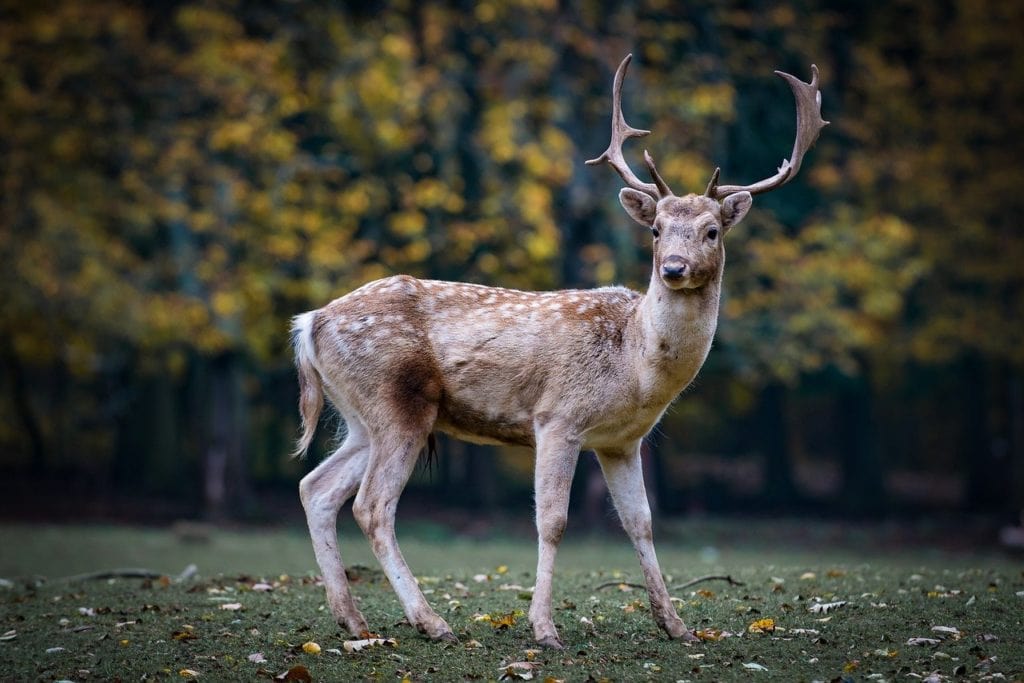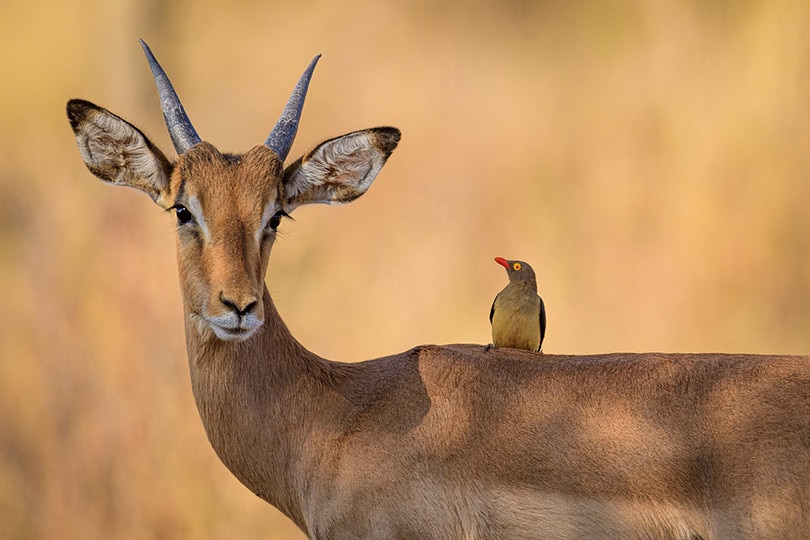Do Deer Eat Birds? The Strange Truth
Last Updated on

Why is it when a herd of deer moves through the forest, they are followed by a symphony of bird alarm calls? Surely birds have nothing to fear from graceful, gentle herbivores? Songbirds have a right to be fearful, though, as deer can and will eat birds.
Although primarily herbivores, many deer species eat birds and their eggs. This behavior is opportunistic, and they will not hunt out meat but instead take advantage of accessible food sources such as carrion and immobile fledglings.
Trail cam evidence documents this strange phenomenon. Not only do deer eat birds, but they eat meat of all varieties.

How Do Deer Catch Birds?
On observation, the slender snout and gangly legs of a deer don’t scream out “predator”. Deer species have evolved physically and behaviorally to exist on an herbivorous diet and cannot hunt other animals.
Their bird-eating habits are simply opportunistic. When faced with an easy avian meal, deer will take the opportunity. For this reason, their bird prey is often fledglings who are vulnerable on the ground. Even being bombarded by angry parent birds doesn’t bother deer who have found a young bird.
Human influence can also provide a means to eat adult birds they wouldn’t usually be able to catch. Scientists found that white-tailed deer were raiding nets set up to catch birds for banding purposes.
Additionally, nests of babies or eggs can make an easy meal when the nest has fallen from a tree or is naturally low in the shrubs. Biologists in Scotland found red deer preying on local populations of seabird chicks that nest on the ground.

Do Deer Eat Meat?
This carnivorous side of deer might surprise you as much as it did us. Deers have always been known as herbivores, and scientists still classify them despite extensive evidence of meat-eating behavior.
They do so because animal matter makes up such a tiny portion of their diet that it’s thought to supplement, not provide essential nutrition. Deer won’t seek to eat any meat but may take the opportunity if presented with it.
Deer don’t only eat birds, but they have been found to munch on available carrion in the forest. This often includes the likes of rabbits or squirrels, but also sometimes larger mammals.
The teeth and jaws of deer are not designed to rip and tear at flesh, so they eat body parts accessible to them, such as legs and heads. They are unable to puncture the body cavities of animals.
If they come across already scavenged carrion, they may get access to internal organs for added nutrition.
Man-Eating Deer
It sounds like something out of a horror story to say deer have been recorded eating human flesh and chewing on bones.
Forensic researchers documented deer disrupting decomposition sites of “body farms.” These facilities research the decomposition process of human bodies and influencing factors to assist in solving crimes.
While it may be unsettling to see a grazing herbivore like a deer gnawing at human bones, this discovery is groundbreaking for forensics. Previously, it was thought only carnivores would chew on bones and disrupt a body.
But now it’s known that herbivores may do so; they can identify herbivore teeth marks and revisit old cases where marks on bones or scattering of remains was a mystery.

Why Do Deers Eat Meat?
Deer are ruminant herbivores and have evolved physically and anatomically to get all their nutrients from plants. Why, then, do they want to eat animals?
While it can’t be confirmed, most scientists agree that animal matter provides a nutrient boost to deer. Especially in particular times, such as:
- Pregnancy
- Growing of antlers
- Food scarcity over winter
- Habitat loss causing food scarcity
These theories are backed up by the fact that most videos circulating of meat-eating deer are pregnant does or young bucks coming into velvet.
Consuming meat and chewing on bones can boost nutrients such as phosphorus, sodium, and calcium to support these times of growth and development.

The General Diet of Deer
Deer are different from other ruminants like cows. Their rumen (the first chamber of the stomach) only holds 2 gallons, only 5% of a cow’s 40 gallons. This means they cannot simply graze on grass and extract nutrients.
For sustenance, they feed on nutrient-dense vegetation, including:
- Crops
- Shrubs
- Seedlings
- Nuts
- Acorns
- Fruit
- Berries
- Flowers
- Bark
Their anatomy has evolved to seek out this vegetation that competitions in their habitat, such as elk and moose, cannot reach. Their narrow snout and long tongue let them strip off plants that these wider-mouthed herbivores can’t access.
Their food sources are enormously diverse. Studies in the southeast United States recorded white-tailed deer feeding on over 400 different species. Their specific diet will vary based on their distribution.
- Related Read: Best Rifle Scopes for Deer Hunting — Reviews & Top Picks

Final Thoughts
You may be seeing deer in a whole new light now. Animals once thought of as peaceful herbivores have been exposed as having a taste for flesh and bone. Just like all forest creatures, deer are just trying to survive and thrive in their environment by any means possible.
Featured Image Credit: hashan, Pixabay
About the Author Sophie Herlihy
After an early start in the veterinary industry and as a conservation educator at Disney’s Animal Kingdom in Florida, Sophie has since been a successful Zookeeper and Conservationist, specializing in native New Zealand species. When she isn't bird watching in native forests, she can be found with her husband on their sheep and beef station, far from civilization. Sophie enjoys her writing career as it provides opportunities to help and support pet owners of all kinds and getting to research and write about a broad range of topics. The only downside is the long list of strange searches in her internet history!
Related Articles:
What Is the Best Binocular Magnification for Hunting? Optical Features Explained
10 Types of Hummingbirds in Arkansas (With Pictures)
8 Types of Hummingbirds in Nebraska (With Pictures)
5 Types of Hummingbirds in Idaho (With Pictures)
3 Types of Hummingbirds in Mississippi (With Pictures)
8 Types of Hummingbirds in Kansas (With Pictures)
5 Types of Hummingbirds in West Virginia (With Pictures)
5 Types of Hummingbirds in Ohio (With Pictures)
